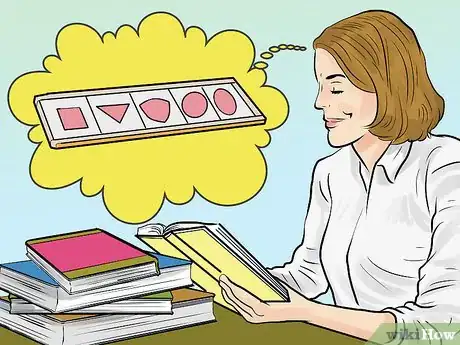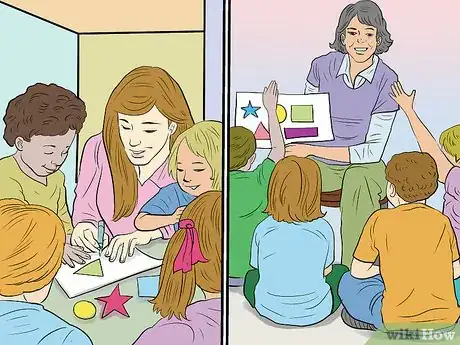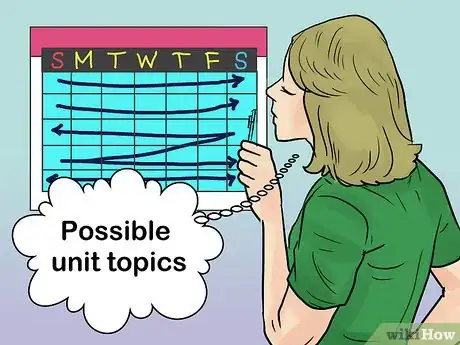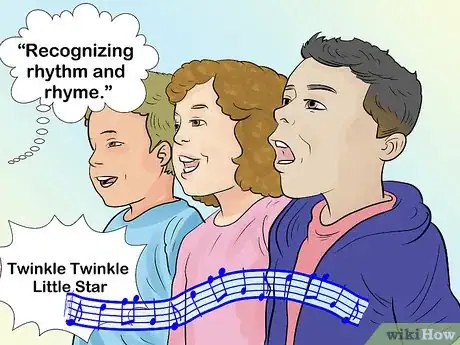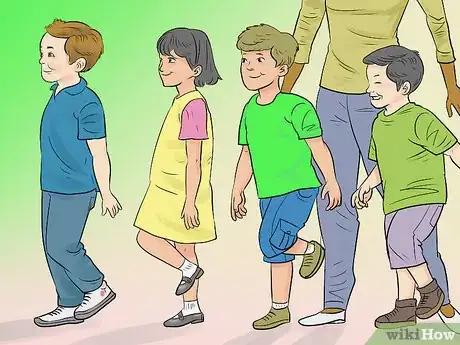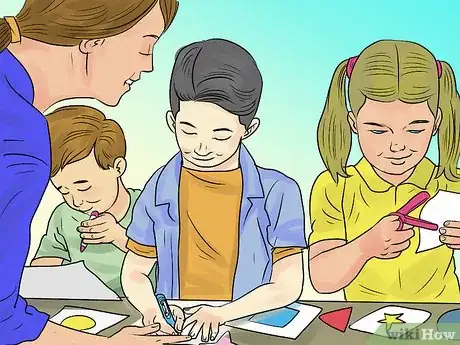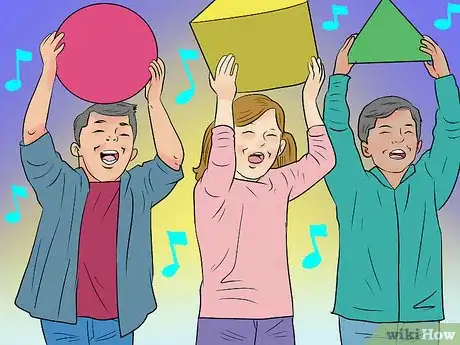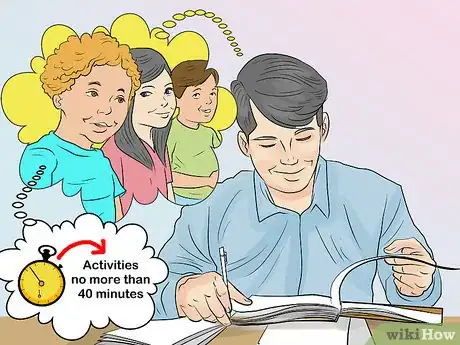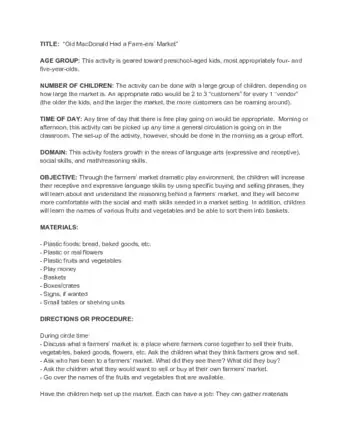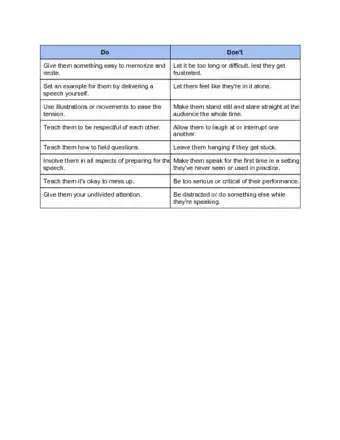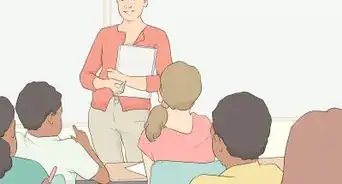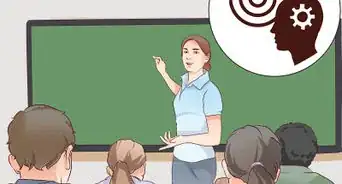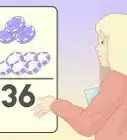This article was co-authored by Jai Flicker. Jai Flicker is an Academic Tutor and the CEO and Founder of Lifeworks Learning Center, a San Francisco Bay Area-based business focused on providing tutoring, parental support, test preparation, college essay writing help, and psychoeducational evaluations to help students transform their attitude toward learning. Jai has over 20 years of experience in the education management industry. He holds a BA in Philosophy from the University of California, San Diego.
There are 12 references cited in this article, which can be found at the bottom of the page.
wikiHow marks an article as reader-approved once it receives enough positive feedback. In this case, 100% of readers who voted found the article helpful, earning it our reader-approved status.
This article has been viewed 99,632 times.
There are a number of different preschool curricula available, but all must be tailored to an individual teacher's style and personality. While some preschool teachers are expected to follow the curriculum designed by another, others have the freedom to create their own. Designing your own curriculum allows for you to tailor learning to your teaching style as well as to the needs of the current class.[1] While it does require an investment of time, after meeting with other teachers, learning the standards, and creating fun activities, you’ll have the makings of a good curriculum.
Steps
Consulting the Professionals
-
1Review curriculum established by early childhood professionals.[2] Not only is there existing curricula created by companies that specialize in curriculum development, but there are also many schools whose curricula are available online.[3] Do a quick online search to get your hands on a variety of preschool curricula. This will give you a sense of the content and structure that is usually used.
- Look into specific teaching methods. Montessori, Waldorf, Reggio Emilia, and High/Scope are useful places to start your research. These frameworks provide details about early childhood experiences, teaching methods, and curriculum design.[4]
-
2Talk to your supervisor. Unless you are working in a new school, your supervisor should have access to some sort of curriculum or teaching guide from previous years. Even if your task is to change the existing curriculum, let your supervisor know that you would like to use the old structure as a model.
- You can also ask your supervisor to pair you with a teacher that works with the same age group or an experienced teacher to mentor you.
Advertisement -
3Talk to other teachers. Talk to other teachers in your school or other preschool teachers in your network. Ask them if they would be willing to share their curricula with you. Most teachers are generous about sharing materials and strategies for student success.
- Ask an experienced coworker to help you. Approach a friendly veteran teacher, and ask for some tips. Most teachers are busy, especially in the beginning of the year, so it may help to come to them with specific questions.
- You could also pair up with a teacher that works with the same age group. Sharing themes, lesson plans, and curriculum materials can benefit both experienced and inexperienced teachers. Not only will it split the workload, but the less experienced teacher might be able to contribute new ideas to an existing curriculum.
Creating a General Structure
-
1Decide on a play-based or academic style classroom. This may be dictated by the type of preschool you choose to work in. On the other hand, you may have the freedom to decide on the structure of your classroom.
- Play-based settings are more student centered, allowing children to choose most of the activities they do throughout the day. Classrooms are usually divided into sections such as a kitchen, a reading area, dramatic play, and so on. The teacher encourages the students to learn through play.
- Academic settings are more teacher directed, and tend to prepare students for specific skills that they will need to learn in kindergarten. Teachers prepare students to recognize numbers, letters, and sounds.
-
2Review the state standards for preschool. Local governments usually have set standards for each age group. Standards are often divided into subject areas like mathematics or social studies. Within each subject area, students have to meet certain performance standards to show that they have made acceptable progress. They are generally skills-based objectives that explain what students should be able to do without going into detail about content.
-
3Organize the year into units. A common way to organize a preschool curriculum is by thematic units. Units are larger topics that can be explored for weeks at a time and through many subject areas. Once you have your units, you can begin to add appropriate, standards-based activities.
- Possible unit topics include animals, community, plants, or family.
- Units generally last from one to five weeks, depending on the amount of material that needs to be covered.[5]
-
4Use the standards to create learning experiences. Each standard should have at least three learning experiences that help students progress. Make a list of experiences that are both developmentally appropriate and capable of meeting the state standard.[6]
- For example, a possible learning standard is “Recognizing rhythm and rhyme.” A learning experience for a unit about planets could have students create nonsense words for Twinkle Twinkle Little Star. This learning experience fits the topic of the unit and also meets the learning standard.[7]
Adding Appropriate Activities
-
1Use hands-on learning. Preschool students learn best when participating in different types of hands-on activities.[8] Avoid long full group sessions with a lot of teacher talk. Instead, encourage children to explore topics through the five senses.
-
2Vary the structure of your activities. It is important to not only vary the activity, but also to change locations in the room and the size of the groups. Let students move from small group to full group activities throughout the day.[9]
-
3Engage with the real world. Design experiments and observations of the natural and social world to encourage curiosity. Allow students to touch, smell, taste, and hear, and observe the world around them.
- If you have a science area, bring physical materials to the science center based on the current area of study. Plan outdoor discovery times to expand upon classroom learning. For example, try an insect hunt during a unit on insects.[10]
-
4Encourage early language skills. Preschool provides an introduction to the more rigorous reading and writing based learning that happens in grade school. Be sure to find developmentally appropriate activities that prepare children for success in later years.
- Promote literacy by decorating the classroom labels, magazines, and letters. Make lists of age-appropriate books to read aloud, and give students time to engage with books individually. Be sure to also allow students plenty of time to develop writing skills through the use of tools like paintbrushes and crayons.[11]
- Include pre-writing activities. These activities promote strength in children’s hands and help them develop the fine-motor skills necessary for writing. Good activities allow children to manipulate small objects with their hands. Try having them cut playdough with child-safe scissors, finger paint, and use crayons to color shapes on graphic organizers.[12]
-
5Incorporate the arts. Use drawing, music, dance, and drama to encourage kids to be creative and learn new skills. Arts focussed activities provide opportunities for students to practice literacy, socialization, and perceptual skills.
- Encourage dramatic play. The benefits of dramatic play range from social-emotional to cognitive and academic. In their make believe sessions, children learn about verbal communication, teamwork, abstract thinking, and more.[13] Create a dramatic play area equipped with props like dolls, clothes, and other household items.[14]
- Sing songs. Songs, especially rhyming songs, help children get sense of the structure of a language. Through singing, they gain phonemic awareness, vocabulary, and rhythm.[15]
-
6Teach about society and community. Preschool is a time when children begin to learn about socialization. Guide students to learn about their communities and their peers through dramatic play, studies of different career paths, and studies of other cultures.
- Encourage socialization and social awareness by teaching about members in the community. Allow students to dress as different community members and act out roles. Plan for the children to meet adults in their community via trips and classroom visits.
-
7Structure your room appropriately. Depending on the teaching method you are using, your classroom may look different. A student-based classroom will have more sections for student exploration such as a sandbox and a water table. An academic classroom may have a larger full-group area for students to learn from teacher-led activities.
- You can adjust the structure based on the current unit you are teaching as well. Add play materials, pictures, and informational texts that relate to the learning concept to each part of your classroom.
-
8Make a plan for structuring your daily lessons. Use your state standards and units listed in your curriculum to write create lessons. Activities do not need to be rigidly structured as they are in grade school. You should, however, create a basic daily routine to follow, as this is helpful to young children. Try to strike a balance between small group, medium group, and whole group activities.
- Avoid spending too much time on one activity. Most children cannot pay attention to one activity for more than the number of their age plus 1 minute (meaning a 4-year-old has a 5-minute attention span).
Sample Activities
Community Q&A
-
QuestionHow would I write a summary for a preschool song?
 Anna Bauer - SLE StudentCommunity AnswerAnswer the questions: What is this song about? How can I put this song in a sentence? Why is this important for the kids to learn?
Anna Bauer - SLE StudentCommunity AnswerAnswer the questions: What is this song about? How can I put this song in a sentence? Why is this important for the kids to learn?
References
- ↑ Jai Flicker. Academic Tutor. Expert Interview. 20 May 2020.
- ↑ Jai Flicker. Academic Tutor. Expert Interview. 20 May 2020.
- ↑ http://www.jumpstart.com/teachers/curriculum/grade-based/preschool-curriculum
- ↑ http://www.earlychildhoodnews.com/earlychildhood/article_view.aspx?ArticleID=367
- ↑ http://stayathomeeducator.com/step-3-decide-on-themes/
- ↑ http://ocw.umb.edu/early-education-development/eec-preschool-learning-standards-and-guidelines/ple-english-language-arts-module.html
- ↑ http://ocw.umb.edu/early-education-development/eec-preschool-learning-standards-and-guidelines/ple-english-language-arts-module.html
- ↑ http://www.brighthubeducation.com/teaching-preschool/67327-developing-your-preschool-curriculum/
- ↑ http://www.brighthubeducation.com/teaching-preschool/67327-developing-your-preschool-curriculum/
- ↑ http://www.jumpstart.com/parents/activities/grade-based-activities/preschool-activities
- ↑ http://www.greatschools.org/gk/articles/what-to-expect-at-preschool-literacy/
- ↑ http://teachingmama.org/prewriting-activities-for-preschoolers/
- ↑ http://www.earlychildhoodnews.com/earlychildhood/article_view.aspx?ArticleID=751
- ↑ http://www.pre-kpages.com/dramaticplay/
- ↑ http://www.earlychildhoodnews.com/earlychildhood/article_home.aspx?ArticleID=478

